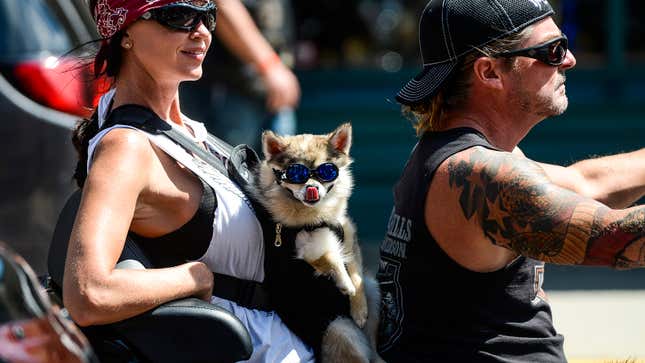
Anyone with a brain could tell that putting on the gigantic Sturgis Motorcycle Rally this year would be a bad idea. Now we have a scientific study to affirm this was a worst-case scenario, an event that appears to be accountable for 250,000 cases of COVID-19 at a public cost of $12 billion.
Excuse me, did I say that Sturgis was a worst-case scenario? What I meant to say was that Sturgis was multiple worst case scenarios rolled into one, as noted by a new paper from the IZA Institute of Labor Economics, a nonprofit supported by the Deutsche Post Foundation and affiliated with the University of Bonn:
The Sturgis Motorcycle Rally represents a situation where many of the “worst case scenarios” for superspreading occurred simultaneously: the event was prolonged, included individuals packed closely together, involved a large out-of-town population (a population that was orders of magnitude larger than the local population), and had low compliance with recommended infection countermeasures such as the use of masks. The only large factors working to prevent the spread of infection was the outdoor venue, and low population density in the state of South Dakota.
Most anyone who has done a cross-country road trip in the summer has seen groups of riders converging on a small town in South Dakota: Sturgis. This year, according to the IZA study, 460,000 people attended, and these people were given a very Trump-era level of safety precautions, as the study explains:
COVID-19 mitigation efforts at the Sturgis Rally were largely left to the “personal responsibility” of attendees (Knowles and Lati 2020), and post-opening day media reports suggest that social distancing and mask-wearing were quite rare in Sturgis (Walker 2020; Porterfield 2020; Orecchio-Egresitz 2020; Groves 2020).
Now, anyone with a bit of sense knew this was going to happen. What’s new is that the report gives us a sense of just how bad this really was. According to the study, Sturgis accounted for a 35 percent increase in cases in South Dakota, and raised rates significantly in every county that visitors returned to. Enough that for the month in which Sturgis took place, the rally was responsible for a fifth of the cases in the entire country:
What’s tragic is that South Dakota was kind of lucking out in terms of COVID. It’s not a dense population, and had low rates even with no lockdown, travel restrictions or mask requirements. And then Sturgis:
The study goes on to note that the lack of actual government systems in place to prevent big, unmasked gatherings made it difficult to actually prevent Sturgis from happening. Officials also figured that the typical Sturgis attendee would show up anyway, so they tried to mitigate the harm as best they could by upping hospital beds and sanitizing surfaces. Nice try! Here’s what these poor public officials went up against:
The Sturgis Motorcycle Rally was held over a 10-day period from August 7 through August 16, 2020, with pre-Rally events beginning on August 3. Estimated attendance was 462,182 (South Dakota Department of Transportation 2020). The Rally included rides and races (drag, motocross, motorcycle), bike shows, poker tournaments, boxing matches, exhibitions, contests, vendors (tattoo artists, rally merchandise, bike washes, apparel), and music events (concerts, disk jockeys, dancers).
Over 30 entertainment groups performed concerts or held events at over the course of the two-week period (80th Sturgis Rally Events Schedule 2020; City of Sturgis Motorcycle Rally Concerts 2020). Venues were both indoor and outdoor, located within Meade County, and included bars on the Main Street of Sturgis to campgrounds outside of city limits, most notably Buffalo Chip. Beginning on August 3, Buffalo Chip held dozens of events every day through the 16th, including a headlining performance by musical group Smash Mouth (2020 Sturgis Buffalo Chip Schedule).
What’s incredible is this study was able to figure out that not only did Sturgis go on this year in spite of COVID, it looks as if it specifically attracted the least safety-conscious people possible. I say that because of this incredible tidbit in the study:
Moreover, liquor store sales in Sturgis were up 27 percent from the prior year, which could be representative of a less risk averse population of attendees given that attendance was down roughly 7.5 percent from the prior year (Bonnet 2020).
The paper concludes that its cost estimate is based on nobody even dying from their positive cases. We know that’s overly optimistic, as the first Sturgis-linked death was already reported last week. Even assuming no deaths, though, our country could have saved money by paying everyone arriving at Sturgis $26,000 to turn right back around:
If we conservatively assume that all of these cases were non-fatal, then these cases represent a cost of over $12.2 billion, based on the statistical cost of a COVID-19 case of $46,000 estimated by Kniesner and Sullivan (2020). This is enough to have paid each of the estimated 462,182 rally attendees $26,553.64 not to attend.
This is a rather dollar-oriented view of this outbreak, which makes sense given that it’s from a labor institute, but I would still suggest reading it in full. It’s incredible to see how vulnerable we all are, even months into this, with no clear government support to keep everyone home from work, insured and wearing a mask.




